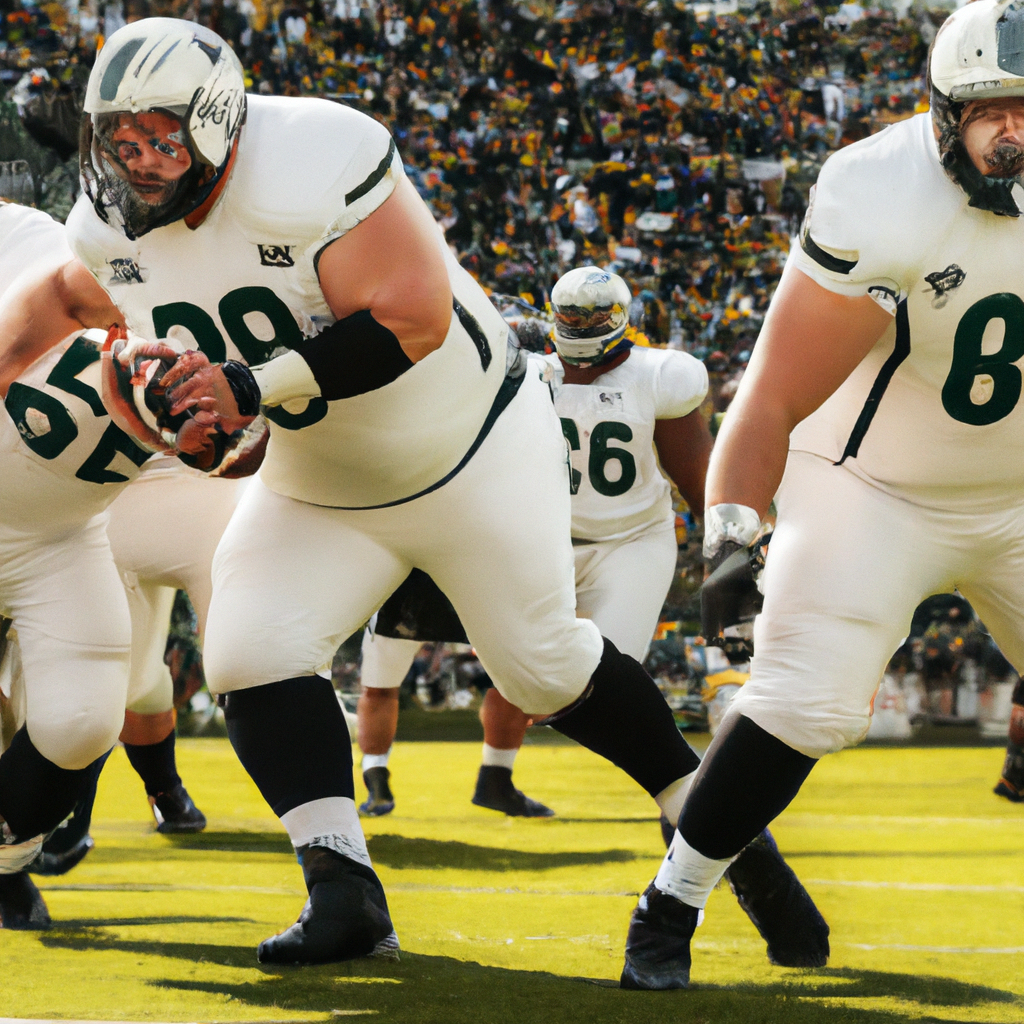Imagine you’re watching a football game, and you can’t help but wonder if there’s a weight limit for linemen. After all, these athletes are known for their strength and imposing presence on the field. In this article, we will explore the fascinating world of linemen and whether there are any restrictions on their weight. Get ready to uncover the truth behind this intriguing question and gain a deeper understanding of the game of football.

The Role of Linemen in Football
Football is a team sport that requires the coordination and effort of players in various positions. Among these positions, linemen play a crucial role in both offense and defense. Linemen are positioned in the line of scrimmage, forming a protective wall and creating opportunities for their team to advance the ball or stop the opposing team’s progress. These athletes serve as the foundation of every successful football team, executing key responsibilities that greatly impact the game’s outcome.
Importance of Linemen in Football
The importance of linemen in football cannot be overstated. On offense, linemen are responsible for protecting the quarterback, who is the team’s leader and primary passer. They create a barrier that prevents defenders from reaching the quarterback, thus providing him with the necessary time to make accurate passes, read the field, and make critical decisions. Additionally, linemen create openings in the opposing team’s defense, allowing running backs to find gaps and excel in their rushing game.
On the defensive side, linemen play a vital role in disrupting the opposing team’s offensive plays. They use their size, strength, and technique to penetrate the offensive line, tackle the quarterback, and disrupt the flow of the game. Linemen consistently apply pressure on the quarterback, forcing hurried throws that often result in incomplete passes, interceptions, or sacks. Furthermore, linemen play a significant role in stopping the opposing team’s running plays by maintaining their stance, shedding blocks, and making tackles.
Different Positions for Linemen
In football, there are different positions for linemen, each with specific responsibilities. On the offensive line, the positions include the center, guards, and tackles. The center initiates each offensive play by snapping the ball to the quarterback, acting as the pivotal connection among the linemen. Guards are positioned on either side of the center and are responsible for blocking defenders to create running lanes or protect the quarterback. Tackles are positioned on the outer edge of the offensive line, protecting against defenders aiming to pass rush the quarterback.
Defensive linemen, on the other hand, include positions such as defensive tackles and defensive ends. Defensive tackles typically line up on the interior of the defensive line, using their size and strength to disrupt the offensive line’s blocking schemes, penetrate gaps, and apply pressure on the quarterback. Defensive ends, positioned on the outermost edge of the defensive line, combine strength and agility to set the edge, contain running plays, and rush the quarterback.
Physical Requirements for Linemen
Size and Strength
One of the key physical requirements for linemen is size and strength. Linemen need to have a substantial build to effectively execute their roles on the field. The size of linemen allows them to engage in physical battles with opposing players, as well as create a strong barrier to protect or attack. Their strength enables them to overpower their opponents, whether in blocking or shedding blocks, tackling, or resisting the opposing team’s pressure.
Body Composition
In addition to size and strength, body composition plays a crucial role in the performance of linemen. A balance between lean muscle mass and body fat is necessary to maintain power and mobility during physical encounters. Excessive body fat can hinder agility and quickness, while an inadequate amount of muscle mass may result in difficulties overpowering opponents. Therefore, linemen must strive for a suitable body composition to maximize their physical capabilities on the field.
Recommended Weight Range
The recommended weight range for linemen varies depending on the level of competition. In general, high school linemen should aim for a weight range of 250-300 pounds, while collegiate and professional linemen often exceed this range. It is important to note that weight requirements can vary among different positions, with some positions favoring more size and strength, while others prioritize agility and speed. Linemen should work closely with coaches and trainers to determine the optimal weight for their specific position and playing style.
Weight Restrictions for Youth and High School Linemen
Youth Football Weight Restrictions
In youth football, weight restrictions are often implemented to ensure the safety and fair play of participants. These restrictions aim to prevent situations where significantly heavier players face off against smaller opponents, minimizing the risk of injuries. While weight restrictions may vary by league, they are commonly based on age and weight limits that determine the appropriate division for each player. Coaches, parents, and league officials work together to enforce these restrictions and create a level playing field for young linemen.
High School Football Weight Restrictions
High school football typically does not have blanket weight restrictions for linemen. However, individual state athletic associations may establish guidelines or rules pertaining to player weight. These guidelines are often based on safety considerations and can encompass factors such as player age, position, or the level of competition. Coaches and administrators at the high school level are responsible for ensuring that the players’ weights are within the appropriate range and for taking necessary precautions to ensure safe play.
Weight Restrictions for Collegiate Linemen
NCAA Weight Guidelines
The National Collegiate Athletic Association (NCAA) provides guidelines for various aspects of collegiate athletics, including weight restrictions for linemen. In recent years, the NCAA has eliminated specific weight limits for linemen, recognizing that different positions require varying sizes and strengths. Instead, the focus has shifted towards ensuring that collegiate athletes maintain a healthy body composition and are fit for play.
Variances Among Different College Programs
While the NCAA may not impose strict weight restrictions, individual college football programs may have their own guidelines and expectations for linemen. Coaches may prefer linemen within a specific weight range, taking into account the demands of their offensive or defensive scheme. However, these guidelines are often flexible and intended to ensure optimal performance rather than excessively restricting weight.

Weight Restrictions for Professional Linemen
NFL Weight Limits
At the professional level, particularly in the National Football League (NFL), there are no strict weight limits for linemen. The NFL focuses more on evaluating an athlete’s skill set, technique, and overall performance rather than solely relying on weight restrictions. Linemen in the NFL come in a wide range of sizes and weights, with individual teams embracing a variety of playing styles and strategies. The emphasis is placed on functional strength, agility, and the ability to excel in the specific role assigned within the team’s system.
Determining Factors for Professional Linemen
The determination of an appropriate weight for professional linemen involves various factors. Coaches and scouts evaluate the player’s overall skill set, analyzing their technique, agility, speed, and strength. The player’s ability to perform the specific tasks required in their assigned position is of primary importance. While size is a consideration, it is not the sole determining factor for success in the professional ranks. NFL linemen are expected to have a suitable combination of size, strength, and athleticism that aligns with the team’s strategic objectives.
Health and Safety Considerations for Linemen
Injury Risk for Heavier Linemen
One of the primary health concerns for linemen, especially those carrying excess weight, is an increased risk of injuries. The repetitive nature of football and the physical demands placed on linemen can place significant stress on their joints, muscles, and bones. Heavier linemen may be more susceptible to injuries such as joint sprains, strains, and stress fractures. Therefore, it is important for linemen to maintain an appropriate weight and prioritize injury prevention strategies, including adequate rest, recovery, and conditioning exercises.
Effect of Weight on Performance
While size and weight can be advantageous for linemen, excessive weight can negatively impact their performance and overall game effectiveness. Carrying too much weight can impede agility, quickness, and cardiovascular endurance, limiting a lineman’s ability to excel in their role. Striking the right balance between weight and performance is crucial for linemen to optimize their play on the field.
Monitoring and Mitigating Health Risks
To mitigate health risks, linemen should engage in regular health monitoring and adopt proactive measures. Regular assessments by team medical staff and strength coaches can help monitor body composition, assess injury risks, and identify areas for improvement. Linemen should also pay attention to nutrition, focusing on a well-balanced diet that supports optimal performance and well-being. By actively addressing potential health risks and adopting proper health management strategies, linemen can decrease the likelihood of injuries and enhance their long-term playing ability.
Training and Conditioning for Linemen
Strength and Conditioning Programs
Training and conditioning programs are essential for linemen to develop the necessary strength, power, agility, and endurance required to excel in their positions. These programs often include a combination of weightlifting, plyometric exercises, sprinting drills, agility training, and cardiovascular conditioning. Strength training focuses on developing functional strength, while agility and conditioning drills improve footwork, speed, and overall endurance. Proper technique and form are prioritized to maximize performance and minimize the risk of injuries. Linemen should work closely with strength and conditioning coaches to tailor programs that suit their specific needs and goals.
Nutrition Guidelines
Proper nutrition is an integral part of effective training and conditioning for linemen. The demands of the sport require linemen to consume adequate calories and nutrients to support muscle growth, repair, and overall performance. A well-balanced diet consisting of lean protein, complex carbohydrates, healthy fats, and a variety of fruits and vegetables is crucial. Linemen should also stay adequately hydrated, as dehydration can impair athletic performance and increase the risk of injuries. Collaborating with sports nutritionists can provide linemen with personalized guidelines and recommendations to optimize their nutrition and fuel their performance on the field.
Evolving Trends in Linemen Weight
Historical Trends
Over the course of football’s history, the weight expectations and standards for linemen have evolved. In the early days of the sport, linemen were generally smaller and lighter compared to modern-day linemen. However, as the game has progressed, the emphasis on size, strength, and power has increased. This has led to an upward trend in linemen’s weight, with many players now exceeding 300 pounds at the collegiate and professional levels. The evolution of linemen’s weight reflects the changing strategies and demands of the game and the importance placed on physical dominance in the trenches.
Current Approaches and Strategies
Recent trends in football have seen a shift towards a more balanced approach to linemen’s weight. While size and strength remain important, there is a greater emphasis on overall athleticism, quickness, and agility. Coaches and teams are recognizing the benefit of linemen who possess a suitable blend of size, strength, and mobility. This shift in approach reflects the growing understanding that excessive weight does not necessarily equate to superior performance, and that agile linemen can excel in both offensive and defensive schemes.
Psychological Factors and Weight Restrictions
Impact on Body Image and Mental Health
Weight restrictions and the focus on size and strength in football can have significant psychological implications for linemen. Pressure to meet certain weight expectations can lead to body image concerns and negative self-perception. Linemen may feel compelled to maintain or gain weight to compete at higher levels, which can lead to unhealthy practices or mental health issues. It is crucial for coaches, trainers, and support staff to promote a healthy body image and provide resources for linemen to address these psychological challenges.
Perceptions and Stereotypes
Perceptions and stereotypes surrounding linemen and their weight can also affect their psychological well-being. Linemen may face assumptions about their intelligence, athleticism, and overall capabilities based on their size. These stereotypes can impact their self-confidence and how they are perceived both on and off the field. Creating an inclusive and supportive environment that recognizes the diverse skills and qualities of linemen can help combat stereotypes and foster a positive mindset among players.
Conclusion
Balancing weight and performance is a critical consideration for linemen in football. While size and strength are important for effectively executing their responsibilities on the field, excessive weight can hinder performance and increase the risk of injuries. From youth to professional levels, proper weight management, training, and conditioning are crucial for linemen to optimize their physical capabilities. The evolving trends in linemen weight demonstrate a growing recognition of the importance of athleticism and agility alongside size and strength. Ultimately, individual determinants and goals should guide linemen in finding the right balance to excel in their positions while prioritizing their overall health and well-being.




